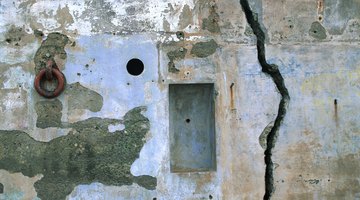Wall Is Cracked From the Floor to the Ceiling
Wall cracks may occur due to various causes, depending on the wall material and the environment. The shape and size of these cracks may help you identify these causes and determine an appropriate course of action.

You may be able to hide small cosmetic cracks, but larger cracks that indicate a serious problem require professional attention.
Concrete Shrinkage
A concrete wall with a vertical crack running from the floor to the ceiling does not indicate a serious problem if the crack is only 1/8 inch wide or less. This type of crack occurs when the wall material loses moisture and shrinks. This crack is more likely to appear if your wall doesn't have horizontal reinforcement steel, also known as temperature or shrinkage steel, which spreads the stress on one part of the wall to other parts. A concrete mix that contains too much water also loses more water and thus has a greater chance of cracking.
Drywall Seams
Drywall comes in sheets that the builder connects at the seams. These seams may appear through wall paint as horizontal or vertical cracks, especially if the builder did not put up the drywall properly. These cracks occur when the joint material at the seams dries and shrinks. These are only cosmetic cracks, and you can easily fix them. Remove the material that hides the drywall seams, and replace it with new drywall tape and several thin coats of joint compound. Let it dry completely, and then paint over it.
Upward Forces
A crack that extends from the floor to the ceiling may also occur because pressure pushes the building structure upward and moves the wall. This crack usually starts out narrow near the floor and gets wider near the ceiling. It may also form a large V-shaped pattern on the wall. This type of crack appears when the soil retains too much moisture and expands, pushing the building structure on top of it upward. If you have this problem, consult a professional contractor for advice.
Downward Forces
Vertical cracks may appear because of pressure pushing or pulling the building downward. This sort of crack has the same shape as a crack from upward pressure, but in the opposite direction. The crack is wider near the floor, and it may form an inverted V-shape. The crack may occur because water has washed away the soil underneath the building or because the soil has lost water and shrunk. The builder may not have properly laid the building's foundation.
References
Writer Bio
Edriaan Koening began writing professionally in 2005, while studying toward her Bachelor of Arts in media and communications at the University of Melbourne. She has since written for several magazines and websites. Koening also holds a Master of Commerce in funds management and accounting from the University of New South Wales.
Photo Credits
- Thinkstock Images/Comstock/Getty Images
- Thinkstock Images/Comstock/Getty Images
More Articles



